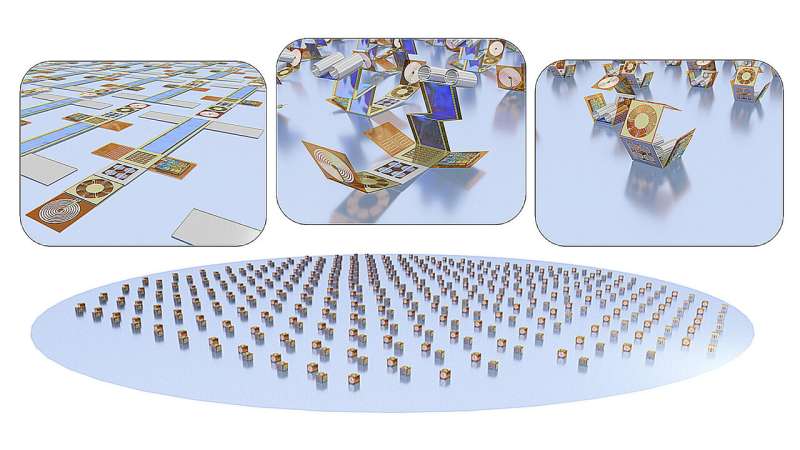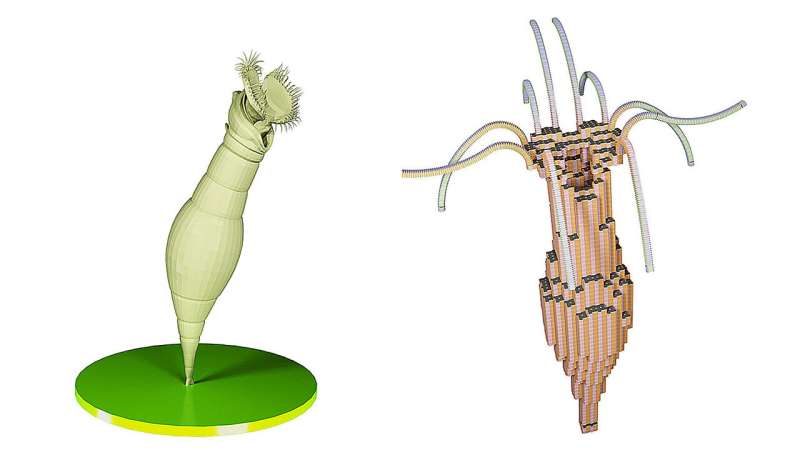
It is now apparent that the mass-produced artifacts of technology in our increasingly densely populated world—whether electronic devices, cars, batteries, phones, household appliances, or industrial robots—are increasingly at odds with the sustainable bounded ecosystems achieved by living organisms based on cells over millions of years.
Cells provide organisms with soft and sustainable environmental interactions with complete recycling of material components, except in a few notable cases like the creation of oxygen in the atmosphere, and of the fossil fuel reserves of oil and coal (as a result of missing biocatalysts).
However, the fantastic information content of biological cells (gigabits of information in DNA alone) and the complexities of protein biochemistry for metabolism seem to place a cellular approach well beyond the current capabilities of technology, and prevent the development of intrinsically sustainable technology.
SMARTLETs: Tiny, shape-changing modules that collectively self-organize into larger more complex systems
A recent perspective review published in Advanced Materials this month by researchers at the Research Center for Materials, Architectures and Integration of Nanomembranes (MAIN) of Chemnitz University of Technology, shows how a novel form of high-information-content “living technology” is now within reach, based on microrobotic electronic modules called SMARTLETs, which will soon be capable of self-assembling into complex artificial organisms.
The research belongs to the new field of microelectronic morphogenesis, the creation of form under microelectronic control, and builds on previous work at Chemnitz University of Technology to construct self-folding and self-locomoting thin film electronic modules.
The new modules carry tiny silicon chiplets between the folds, for a massive increase in information processing capabilities. Sufficient information can now be stored in each module to encode not only complex functions but fabrication recipes (electronic genomes) for clean rooms to allow the modules to be copied and evolved like cells, but safely because of the gating of reproduction through human operated clean room facilities.

Electrical self-awareness during self-assembly
In addition, the chiplets can provide neuromorphic learning capabilities allowing them to improve performance during operation. A further key feature of the specific self-assembly of these modules, based on matching physical bar codes, is that electrical and fluidic connections can be achieved between modules.
These can then be employed, to make the electronic chiplets on board “aware” of the state of assembly, and of potential errors, allowing them to direct repair, correct mis-assembly, induce disassembly and form collective functions spanning many modules. Such functions include extended communication (antennae), power harvesting and redistribution, remote sensing, material redistribution etc.
So why is this technology vital for sustainability? The complete digital fabrication description for modules, for which actually only a limited number of types are required even for complex organisms, allows their material content, responsible originator and environmentally relevant exposure all to be read out. Prof. Dagmar Nuissl-Gesmann from the Law Department at Chemnitz University of Technology observes that “this fine-grained documentation of responsibility intrinsic down to microscopic scales will be a game changer in allowing legal assignment of environmental and social responsibility for our technical artifacts.”
Furthermore, the self-locomotion and self-assembly–disassembly capabilities allow the modules to self-sort for recycling. Modules can be regained, reused, reconfigured, and redeployed in different artificial organisms. If they are damaged, then their limited and documented types facilitate efficient custom recycling of materials with established and optimized protocols for these sorted and now identical entities. These capabilities complement the other more obvious advantages in terms of design development and reuse in this novel reconfigurable media.
Prof. Marlen Arnold, an expert in sustainability of the Faculty of Economics and Business Administration says, “Even at high volumes of deployment use, these properties could provide this technology with a hitherto unprecedented level of sustainability which would set the bar for future technologies to share our planet safely with us.”
More information:
John S. McCaskill et al, Microelectronic Morphogenesis: Smart Materials with Electronics Assembling into Artificial Organisms, Advanced Materials (2023). DOI: 10.1002/adma.202306344. onlinelibrary.wiley.com/doi/10.1002/adma.202306344
Provided by
Technische Universität Chemnitz
Citation:
Morphogenesis of self-assembling microelectronic modules could yield sustainable living technology (2023, October 11)
retrieved 11 October 2023
from https://techxplore.com/news/2023-10-morphogenesis-self-assembling-microelectronic-modules-yield.html
This document is subject to copyright. Apart from any fair dealing for the purpose of private study or research, no
part may be reproduced without the written permission. The content is provided for information purposes only.










